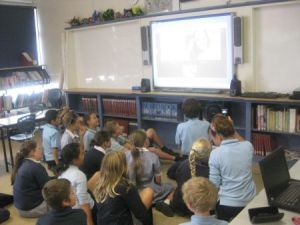The Changing Face of Teaching
This year I teach ICT or computer studies to years 4 and 5 students for one lesson per week. (My school is in south Eastern Australia. It is a rural school that is isolated geographically and culturally.) Lorraine Leo, a long term online colleague, also teaches this age group at Jackson School in USA. Hoping that we could work together on some global project, Lorraine suggested we get involved in the World Friends Scratch project. This project is being co-ordinated by Professor Yoshiro Miyata of Japan. Knowing that the grade 4/5 boys (who tend to be disengaged in the normal classroom) would like working with Scratch, I agreed. However, I have never put time aside to sit down and learn how to use it, despite being highly interested in its use and potential. At that point in time, I did not have any spare time to put into learning how to use it.
Soon after this discussion, my grade 4/5 class went to the library to watch a skype videoconference linkup with Lorraine and her student Lana from USA. It was Wed night at 7:30pm Lana’s time and Thursday 11:30am our time. Students watched intensely as Lana used the screen share facility of skype and stepped us through the creation of a sprite, how to make it move and how to add speech bubbles that would appear when it bumps into another sprite.
At the end of this presentation, students were able to ask Lana questions and 50 minutes disappeared very quickly. Just as the bell went, Lana took her laptop to the window to show us the snow that had fallen outside. Despite the darkness we could see it quite clearly. [/caption] Students then proceeded to create their sprites during following ICT lessons. Lorraine created two screencasts which quite clearly demonstrated the steps required and emailed them to me. The links to these were shared on my class blog. Students were able to work at their own pace and as some students completed the tasks, they mentored the others. I became a facilitator and simply watched the learning begin and blossom. The first group of students have now completed their sprites, tested them and some were uploaded to the public gallery on Thursday, ready to be transferred to the World Friends site global project site.
What we learnt
- Digital citizenship – the necessity to make our sprites resemble our own persona. One student had made an animal sprite, another gave their body a different colour. They were changed to bear a greater likeness to themselves for global sharing.
- How to use screen casts effectively. How to use video tutorials that Lorraine Leo created to help them learn.
- Students can become effective instructors and mentors, even when they are virtual. They talk to each other in their own language.
- The necessity to follow each of these steps or the sprite would not talk when bumped.
- Expertise no longer matters if a teacher has a strong learning network
Why it worked so well
- The engagement of student learning with technology –
- having an American student teach them virtually
- working with a tool that is not obviously literacy or numeracy based
- having experts teach the students – both Lana via skype and Lorraine via the screencasts
- students mentoring other students within the classroom.
- A real project with an authentic audience
How does this fit the pedagogy of learning? (adpated from the ISTE NETS standards for students) Students will
- use digital media and environments to communicate and work collaboratively on a global scale, to support individual learning
- contribute to the learning of others
- connect, interact, collaborate and publish with global peers, experts and general community members, including family.
- use a variety of media and digital environments to connect, communicate and create.
- share learning spaces
- communicate information and ideas effectively to a variety of digital audiences using a variety of media and formats
- develop cultural understanding and global awareness by engaging with learners from other cultures.
- Promote and model digital citizenship and responsibility.
Our sprites will be uploaded to the no. 3 World Friends space
Our next challenge: Joining in the next great Scratch project with Professor Yoshiro Miyata -The Lunchbox Project.





I really enjoyed reading you story. I think this is a wonderful example of how different technologies can allow schools that are in isolated areas/cultures participate in global activities. You make a great point about having experts teach the students. One teacher can't be an expert in everything out there, but using technology to bring in experts really opens the door for opportunities for student learning.